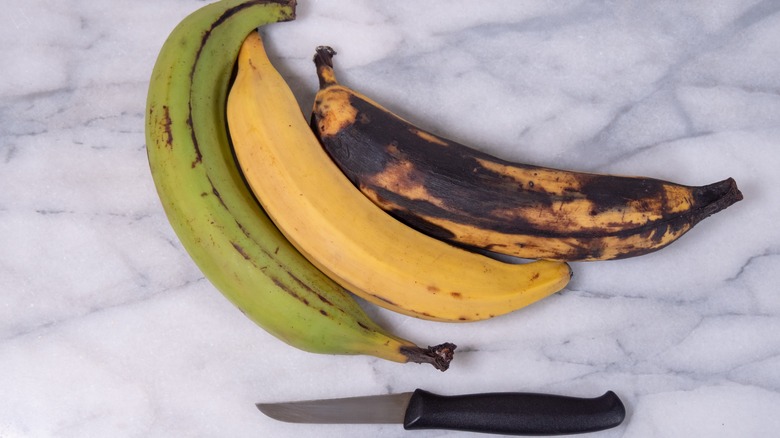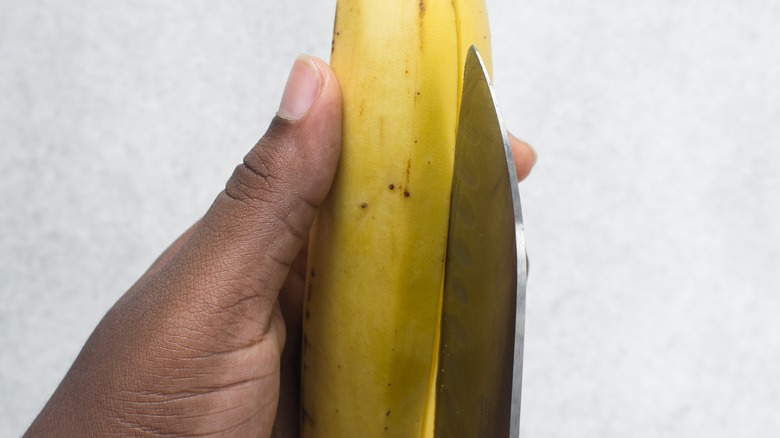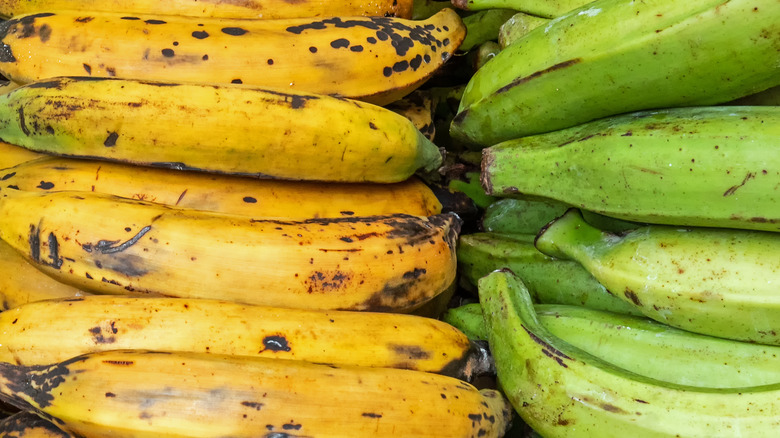How To Properly Peel A Plantain Like The Pros
With their subtle sweetness and versatility in dishes, both savory to sweet, plantains have become a beloved fruit and staple ingredient across many cultures. However, if you think peeling a plantain is as simple as peeling a banana, you're in for a serious surprise. Plantains may look like their cousin, but they differ in a few ways — peeling being one of the most significant differences. While you can easily peel a banana with your hands, attempting to do the same with plantain likely won't work. Unlike their sweet banana counterparts, a plantain's peel is too tough to be simply stripped away. So instead of peeling, you need to cut it off.
While that might sound like a hassle for most, it's worth it when you cut back the peel to reveal a pale, ripe plantain ready for cooking. If you're ready to explore the culinary versatility of this fruit, we'll guide you through the step-by-step process of peeling a plantain and share some tips on when they're ready to be prepped.
How to remove a plantain's peel
To get started, cut each end of the plantain with a sharp knife (just enough to take the hard bits off so you can see the fruit's flesh inside). A paring knife works great here as it's sharp but small, offering greater precision than a larger knife.
Then look or feel for the ridges on the skin, as they'll serve as your guide for making the necessary cuts. Make a shallow cut in each ridge, then use the knife or your fingers to gently tear the skin away from the flesh. If the plantain is ripe, you might only have to cut into one of the ridges, and the skin should start to peel away from the fruit with ease.
With the skin removed, you'll be left with a naked plantain ready to be used in all sorts of recipes, from savory dishes like tostones and mofongo to sweet treats like plantain bread and plátanos en tentación. Depending on the dish you're making, you'll have to cut the plantain further — typically diagonally or horizontally if you're making tajadas or in slices to fry and later mash for tostones.
Is your plantain ripe for peeling?
The secret to peeling a plantain with ease lies in its ripeness. A ripe plantain is much easier to peel than a green one. So, how do you know when your plantain is ripe and ready for peeling? First, look for external cues. A ripe plantain will have a deep yellow or blackened skin. The darker the skin, the sweeter and softer the flesh inside will be. Additionally, the skin will easily pull away from the fruit when it is ripe, whereas an unripe plantain will hold onto its skin stubbornly.
Another way to check if your plantain is ripe is by giving it a gentle squeeze. A ripe plantain will be slightly soft and yield to pressure, while an unripe one will be hard and unyielding. If the plantain is too soft or mushy, it may be too ripe and unsuitable for cooking. In this case, it is best to use it for making sweet treats such as plantain fritters or even banana bread.
They say patience is a virtue, and it definitely rings true when it comes to peeling plantains. Don't shy away from cooking with this versatile ingredient just because peeling it seems too hard. Wait for your fruit to ripen, and you'll be rewarded with a sweet and tender treat.


